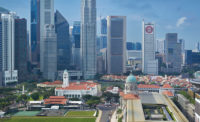A major renovation and expansion of the National Museum of Singapore by Singapore-based W Architects presented a tabula rasa for light designers at Lightemotion and exhibition designers from GSM Group. François Roupinian, who founded Montreal-based Lightemotion in 2002, likens the museum’s 126,000-square-foot addition to a “complete black box.” Founded as a natural history museum in 1887, the institution used its recent construction project also to expand its curatorial focus, which now encompasses cultural identity and nation building. This broader scope meant that the museum’s collection would be spread thin across the new galleries, creating the need for the exhibition and lighting designers to engender a sense of intimacy in the cavernous interiors.

In addition to providing the illusion of a smaller scale, the designers at Lightemotion helped reinforce the museum’s narrative. “We tried to make lighting a third character,” states Roupinian. “The lighting became the scenography.” In a gallery devoted to Singapore’s theatrical traditions, the firm suspended bare light bulbs from the ceiling, letting the electrical cords swag this way and that. A century ago, Singaporean opera singers worked as itinerant performers, explains Roupinian. So “we tried to create a bit of the feeling of the nomadic dressing room, where performers would hang all those light bulbs to do their makeup,” he says.
While the original galleries now focus on themes such as fashion and theater, the extension designed by W Architects houses the museum’s permanent collection. Rather than divide galleries thematically, GSM designed two paths that follow the chronology of Singapore’s political and social histories. One of the rare intersections between the two paths serves as the entryway to galleries devoted to the Japanese occupation. Here, too, suspended lighting does the work of props. “We wanted people to experience—in a metaphorical way—the anguish and fear [that residents felt during the occupation],” Roupinian says. So GSM designed an angled concrete wall that outlines the route, and Lightemotion illuminated it with attenuated Edison bulbs whose filaments are dimmed to 5 percent. “They shake a bit just so you can feel the fragility,” Roupinian says of the quivering filaments. Prior to this junction, along the social-history path, museumgoers can explore a re-created opium den where paper lanterns hang from the ceiling; a metal-halide/fiber-optic system integrated in the raised floor uplights a metal-mesh ceiling, where shadows evoke smoke. As the permanent collection approaches the most recent decades, a gallery devoted to contemporary manufacturing features a ceiling of myriad luminaires fabricated in Singapore.
The designers also used projected images to help fill the National Museum’s abundant space. In one example, at the start of the permanent collection, they created a collage of still images that dance across lycra panels stretched inside a drumlike volume. At the end of the journey, films of contemporary Singaporean life play on canted walls, and embedded fiber optics in vitrines give the impression that the exhibition cases have somehow captured the spillover light.
A cinematic approach characterizes GSM and Lightemotion’s work at the National Museum of Singapore. In the pools of light that underscore certain artifacts, for example, the designers created counterparts to the range of luminous and emotional intensity found in film. “Singaporeans are used to a wash of fluorescent light,” Roupinian says. That the National Museum of Singapore does the opposite offers testimony to a trusting client, and adds a new layer of meaning to the island nation’s relatively brief history.
PeopleLighting designer LIGHTEMOTION 4030 St-Ambroise, Suite 201 Montréal, Québec H4C 2C7 Canada ph: 514.789.0178 fx: 514.789.0179
Principal:
Senior designer:
Designer:
Exhibit designer 4898 boulevard de Maisoneuve Ouest, 3e étage Montréal, Québec H3Z 1M8 Canada ph: 514.288.4233 fx: 514.288.3820
Project team:
General contractor and project manager GSM BUILD 4898 boulevard de Maisoneuve Ouest, 3e étage Montréal, Québec H3Z 1M8 Canada ph: 514.288.4233 fx: 514.288.3820 |
ProductsGeneral museum lighting LSI
Theatrical projectors ETC
Selecon
Fiber optic systems Luxam
Advanced Lighting Systems
Architectural fixtures iGuzzini
Lamps and light sources Osram Sylvania
GE
Philips |



Post a comment to this article
Report Abusive Comment